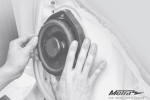We’ve received a bunch of questions lately about charging systems and current requirements, so this issue we’ll get you some answers regarding your cars electrical health.
Q: Hello. I think you have a great mag, and I’m hoping you can help me with a technical question. I’m looking at buying a system for my new car, a 2008 Dodge Challenger. I want to replace all the speakers, and add a 4 channel amp and a big subwoofer amp, and a pair of 12” subwoofers. I’m worried about the cars charging system being overworked by the amplifiers. Will I need a bigger alternator? I don’t want to void the warranty by making a modification. How much amplifier power can I go with before I start to worry? Hemi Fan - via email
A: Well, the answer to your question is really, it depends. The amount of current an amplifier (or amplifiers) draw is directly proportional to how loud you like to play your system. Another factor for consideration is the average engine speed during most of the time you’ll be listening. I’ll give you a couple of examples to illustrate what I mean. Let’s say that you went with a moderate power system, with a maximum current draw of 100 amperes. The factory alternator in your Challenger is going to max out at about 60-75 amperes when the engine is at 2500-3000 rpm. Obviously, it will take some of the available current just to operate the car. Let’s say the car takes a total of 20A. That leaves 40-55A for the system. Now, if you are driving around town with the system really cranked, idling at a lot of stoplights and seldom getting a sustained 2500 rpm, you are going to use up everything the alternator has, and be drawing energy from the batteries reserve. If you drove like this every day, you’d find your battery will need replacing fairly frequently, and you’ll probably go through a few alternators over the life of the car. In severe examples, the car may be slow to crank over when starting as well.
But, if you took the same system in the same car, and usually listened to it at only 60% of max volume, and did a lot of highway driving, the electrical system would be much less strained, and probably would require less upkeep.
So you see, while it’s possible to calculate how much current any given system needs, it’s more complicated to determine when you have enough charging system to power it, because much depends on your listening and driving habits.
As a very basic rule of thumb, after the system is installed, keep an eye on the battery voltage. It should always be above 13.5V when the car is running, and should only dip noticeably when a hard bass note hits. If you are getting a lot of headlight or dash light dimming, or if the average voltage isn’t being maintained, it’s a sign you need more current.
Q: Hey, I would like to know how many batteries I need to install to run 2 MTX 1000 watt Class D amplifiers. I’ve asked a bunch of people and been told everything from 1 to 4 batteries. I know they all need to be the same, but I don’t know how many I need. What’s the real deal? Boom2live – via email
A: Hey back atcha Boom. This is a common question, and a frequently misunderstood topic. There are a few things to understand before we get to your answer. First of all, when the car is running, remember that the alternator is the source of energy for all the electrical devices in the car. Current does not come from the battery until you have exhausted the output of the alternator. With that in mind, a lot depends on your listening and driving habits, as we covered in the previous question. Generally speaking, you shouldn’t really need a second battery for a pair of efficient one-kilowatt amps.
In most cases, if you find your voltage dropping under load the best thing to upgrade is the alternator. This will give you more available current at a higher voltage to “run” your amps. Another benefit of an alternator upgrade is that most of the higher performance units also produce more current at lower RPM’s as well. Then, if you listen and drive in a manner that does not frequently use up all the alternators output, you don’t need any additional batteries. In fact, each battery you add actually causes an increased parasitic load on the alternator, and will draw some current constantly, even when fully charged.
However, in a demo car type of situation or if you do a lot of listening with the engine shut off, or even at very low rpm, you may find you need a separate battery to extend the amount of time the system will play. In cases like this, you can isolate the “stereo battery” from the vehicles battery so you can still start the car even if the other battery is very low. If this is the case, make sure you get a battery that is designed to be frequently discharged, or you’ll be replacing it often. But generally speaking, multiple battery systems are seldom required on street driven cars, and are more likely to be found on very high power “demo” cars or in systems designed for high SPL.
Q: Hi. Love the magazine, and the hot chicks! Keep ‘em coming! (and send some babes my way) I have a 2004 Mitsubishi Lancer with a decent system in it and I installed myself. I have a Rockford Fosgate Punch 4 channel amp driving MB Quart mids, and a Power series BD amp for my JL Audio subs. When I crank up on the volume, my lights sort of flash to the beat of the music. While it’s kinda cool to watch, I don’t think it’s good for my amps. How can I fix this? The car has the factory alternator and battery. My friends and a local shop tell me I need more batteries, but there’s no room for them. DirtyMind – St. Louis
A: Quite a name you chose… Glad to hear you enjoy the magazine, and we’ll do our best to keep you happy. We asked several models if they were up for a visit to St. Louis, but sorry with your nickname, no takers there. Maybe we can help you with your tech question though! The situation you described won’t really harm your amps, but it’s certainly not an optimal condition. Since you didn’t go into much detail about the conditions when your lights dim, I’m going to assume that the lights flash mostly when the car is sitting at an idle. The lights are flashing because to create the bass notes in your music, the amps have to draw current. If there isn’t enough current coming out of the alternator, the cars voltage will drop, and for that period when the voltage is lower, the lights will dim. In mild cases, simply revving the motor to a couple thousand rpm will allow the alternator to provide enough current to stop the flashing. Sometimes the current demand is so great that that’s still not enough, and then you need some help.
In your case I don’t think the original battery would have lasted this long if the conditions were severe, so I’ll assume you fall into the first scenario. There are several things I’d check into on your car. First, your battery is 5 years old. That’s a pretty good life for a car battery, and you may want to think about giving it a headstone that reads, “well done, my good and faithful servant”, and upgrading it. Second, have a close look at how the battery ground terminal is connected to the cars chassis. Lots of cars (including yours) use a 12 gauge wire, and the entire electrical system current has to go through this one little conductor! I highly recommend a 4 gauge cable from the batteries negative post to the same spot the small gauge wire was connected to. This can do wonders for voltage drops. Another suggestion is the addition of a high quality, large value storage capacitor as close to the amplifiers terminals as possible. But be careful with this one, because there are very good performing capacitors available, and there is also some junk out there. The good caps will make a significant difference in the light dimming, and in the sound quality of the system. The bad ones are a complete waste of money. To make sure it’s money well spent, look for a dealer who’ll offer to install one temporarily and see if it helps. If the difference isn’t noticeable right away, move on to a different brand.
Q: I am hoping you can answer a question for me and help me win a bet with a buddy. We both work for car stereo shops and we have a disagreement on something. He says that when anyone installs a large system that requires a separate power cable run to the battery, you should also always install a ground cable of the same gauge as well, from the battery back to the amp. I prefer to ground my amps using the cars chassis, and I generally don’t have any ground problems. Who is right, and why? And please be clear, there is a hundred bucks, tix to the races, and shop pride riding on your answer. Gambler – Las Vegas
A: Dear Gambler,
You are right. He’s an idiot. Tell him to pay up. Enjoy the races.
Okay, I’m just kidding about the idiot part, but actually you are right, and he certainly loses the bet. I’ve actually been paid to fix noise problems that were caused by adding ground cables as your friend describes. The practice is not only unnecessary, but it actually effectively doubles the amount of radiated noise on the chassis of the vehicle. Each of those high current carrying cables acts as a small noise transmitter! Adding a second one is like asking for more noise. The welded steel chassis of a modern vehicle is plenty good enough to handle any normal high power audio systems current. Unless you’re doing a system that has over 500A of current draw, I wouldn’t worry about adding dedicated ground cables. Your methods are fine, but don’t forget to upgrade the OEM battery to chassis wire. Not only does your method have a much lower noise signature, you’re saving your customer the cost of additional cable and distribution blocks. Keep up the good work.
Related Articles
 Metra to Show New Speaker Adapter Plates and Harnesses at SEMA 2024
Metra to Show New Speaker Adapter Plates and Harnesses at SEMA 2024
 Stingray Brings Karaoke to Select Ford Vehicles
Stingray Brings Karaoke to Select Ford Vehicles
 Massive Audio's New GTR Series and GTX-H Series Subwoofers
Massive Audio's New GTR Series and GTX-H Series Subwoofers
 Metra Electronics TurboTactile Dash Kit for 2019+ RAM Trucks
Metra Electronics TurboTactile Dash Kit for 2019+ RAM Trucks
 Metra Electronics 107-HO1 Dash Kit for 2022+ Honda Civic
Metra Electronics 107-HO1 Dash Kit for 2022+ Honda Civic
 The Importance of Keeping a Vehicle Battery Fully Charged
The Importance of Keeping a Vehicle Battery Fully Charged





